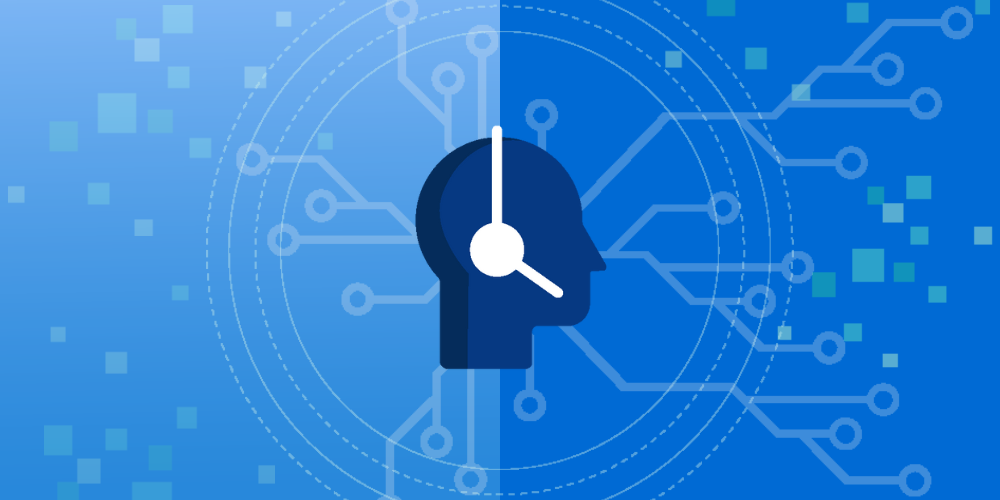Long before the introduction of ChatGPT in November 2022, Artificial intelligence (AI) had made its way into the world of customer service. It’s no secret that AI has the potential to fundamentally change the customer service experience for companies, employees and customers, and already has. From chatbots and tailored suggestions to advanced speech recognition technology, the continuous advancements in this field have propelled the discussion surrounding AI in customer service to new heights. So, let's explore some history and AI customer service examples, and delve into the benefits and challenges that AI presents in today's contact centers along with its impact on the customer experience.
Journey through the AI landscape
Artificial intelligence, or AI, isn't just a flashy, modern buzzword. This term was first introduced in 1955 by American computer scientist John McCarthy in a research project funding proposal.
Fast forward 50+ years – can you recall the wave of intrigue when Apple unveiled 'Siri' in 2011? That clever voice assistant that lives in our pockets, ready to answer any question or set any reminder, is AI. From that moment, the role of AI in our daily lives has only expanded, with new applications cropping up at a blistering pace.
Unpacking AI: a simple approach
Stripped down to its basics, AI is about equipping computers with human-like intelligence capabilities. This empowers them to solve problems and provide answers on their own, all without needing a new set of instructions for each new task (source: Wikipedia).
When you dive into AI, you'll frequently come across phrases like 'machine learning' and 'natural language processing' (NLP). These aren't just buzzwords, but rather significant AI technologies that are propelling us towards an increasingly automated future. Let’s take a deeper look at what they are and how they work in a contact center.
Machine learning and natural language processing: an overview
Machine learning is an integral subset of artificial intelligence. Imagine algorithms as mathematical detectives, identifying patterns and regularities hidden in substantial data. They craft solutions that parallel human problem-solving. Essentially, they create knowledge from direct experience. Machine learning algorithms empower AI with a unique ability to process, learn from, and improve upon the data they handle, without any need for explicit programming.
Now, let's illustrate this with some applications that bring these concepts to life in contact centers:
- Virtual assistants: Ever chatted with a digital helper? You've experienced machine learning in action.
- Chatbots: They're the friendly, always-on-hand customer service reps, tirelessly working behind the scenes.
- Forecasting: Machine learning identifies patterns in contact volumes and handling times, delivering super-accurate forecasts with negligible effort.
Natural language processing (NLP) enables machines to understand and process human language, both spoken and written. The ultimate goal? Facilitating natural, seamless interactions between humans and machines.
Here are some fascinating ways NLP manifests itself in contact centers:
- Sentiment analysis: It's like having an emotional barometer that gauges sentiments or subjective opinions within a conversation.
- Transcription of conversations: Transforming spoken words into written texts, helping preserve every vital detail.
- Machine translations: Erasing language barriers and broadening the scope of communication.
The role of AI in customer service
Customer service has experienced quite the evolution — from humble telephone calls to dynamic AI customer service bots to advanced cloud technologies. We're standing on the brink of a major revolution, courtesy of the latest advancements in artificial intelligence.
Gartner predicts that by 2026, we can expect an automation storm with one in ten agent interactions predicted to be automated — an astonishing leap from the current 1.6% of interactions managed using artificial intelligence.
For contact center managers, the recipe for success is a combination of goals—each one finding a valuable ally in artificial intelligence. Picture AI helping to:
- Deliver unmatched customer experiences that keep them coming back.
- Boost employee productivity, turning every day into a high-performance day.
- Heighten employee satisfaction, creating a positive workplace environment.
- And finally, reduce costs, paving the way for sustainable and efficient operations.
How AI can improve customer satisfaction
In today's high-demand customer service landscape, businesses face an uphill battle managing increased interactions with lean teams. Customers won't settle for less than quick and efficient resolutions to their queries.
AI is a game-changer. Customers interact with AI customer service chatbots, providing prompt solutions to their inquiries round-the-clock. No more languishing in phone queues—AI customer service solutions emulate human interaction, making the process seamless.
Further, AI simplifies the often complex IVR systems in contact centers. Replacing nested prompts with intuitive voice assistants, AI ensures customers find the right service fast, with just a few words.
The result? Customers get swift, satisfactory resolutions, and employees are freed from repetitive tasks. AI can improve customer satisfaction, paving the way for a bright customer service future.
How AI can make your employees more productive (and happier)
In a recent study, 60% of customer service agents agree that AI boosts their team's efficiency and productivity. How does this work in practice?
- AI voice assistants streamline the process by recognizing customer issues and connecting them to the right employee, thereby saving time on call transfers. By automating routine tasks, AI lightens the load on your team, allowing them to focus on more complex issues.
- AI also aids employees during customer interactions by offering real-time insights and recommendations, leading to quicker resolution times and enhanced productivity.
- In essence, AI frees up your team from mundane tasks and provides valuable support, increasing employee satisfaction and fostering customer loyalty.
How AI makes your contact center more efficient
One standout advantage of artificial intelligence in customer support? Its 24/7 readiness. This means queries find solutions even outside office hours, resulting in faster responses and an elevated level of service.
By taking over mundane tasks, AI allows your employees to dive into complex issues. The result? A team functioning at peak productivity and efficiency.
AI's talent for identifying data patterns allows it to predict contact volumes across various channels accurately. Its intelligent algorithms sift through historical data, spotting trends, seasonal variations, and workload fluctuations. With precise forecasting, staffing becomes more strategic, aligning workforce availability with demand.
Additionally, AI helps trim costs linked to training and onboarding. With AI-aided training systems, new hires efficiently grasp work processes. AI-powered conversation simulators present a variety of scenarios, helping new employees hone their problem-solving skills and gain confidence for live interactions.
The top use cases of AI customer service solutions in contact centers
Virtual Assistants and chatbots are leading the charge in AI-powered customer service. A striking 76% of U.S. contact centers already employ chatbots. Of those that do not use chatbots, 31% plan to adopt them soon. These digital assistants, accessible via websites, apps, or social media, handle common queries and simple issues, freeing your employees from repetitive tasks.
Sentiment analysis plays a crucial role too, using Natural Language Processing (NLP) and machine learning to decode moods and opinions in texts or conversations. Imagine an AI recognizing customer frustration through vocal cues, guiding agents in real-time to handle the situation better. It also helps identify areas where specific employees may need additional training.
AI's magic doesn't end there. With real-time AI customer service chat translation, it bridges language barriers, enabling smooth communication with customers in their native language—a boon for globally operating centers.
Conversation transcription, another artificial intelligence application, transforms verbal interactions into text, providing in-depth insights into every interaction. This text data serves as a valuable tool for training, performance monitoring, and regulatory compliance.
Consider traditional IVR systems—they often prolong customer interactions with their predefined rules. AI-powered IVRs, on the other hand, provide a personalized experience where customers can voice their concerns naturally. The system responds like a human, maintaining the conversation flow, and directs complex queries to a competent agent.
AI's capacity for analyzing large data sets and making accurate predictions is harnessed in workforce management software. It takes into account historical data, seasonality, and outliers, and forecasts contact volumes and handling times. This allows for efficient staff scheduling, reducing instances of over or understaffing.
Challenges and concerns in implementing AI in contact centers
Though AI's benefits in contact centers are substantial, it's important to recognize the associated challenges and concerns, including implementation effort, data privacy worries, and potential job shifts.
The transition to AI demands careful consideration of how it aligns with existing services and technologies. Implementing a hodgepodge of AI applications can complicate operations and create data silos, hindering agent performance.
Data privacy remains a prime concern as AI continues to evolve. Organizations must strike a careful balance between technological advancement and adherence to data protection laws.
While fears of job loss due to artificial intelligence are common, it's crucial to see AI as a tool for enhancement, not replacement. It assumes routine tasks, freeing up your team for more nuanced work.
While AI can handle straightforward queries, the intricacies of human communication often necessitate a personal touch. In fact, a recent survey showed that 60% of customers believe humans understand them better than chatbots and prefer human interactions for complex inquiries.
To fully leverage AI in customer service, effective staff training is a must. This might involve building new skill sets like data analysis, digital competence, and an understanding of AI and machine learning. Developing or utilizing AI customer service training programs that impart these skills can set your team up for success in an AI-enhanced workspace.
Conclusion
Artificial intelligence isn't a passing trend—it's here to stay, poised to shape the future of businesses, particularly contact centers. AI, with its myriad applications, from conversational AI customer service chatbots to real-time translations, equips contact centers to function more efficiently and economically.
It's clear that AI can transform customer service. With reduced wait times, 24/7 self-service, and an overall enhanced experience, customers reap undeniable benefits. At the same time, it bolsters employee productivity and satisfaction by taking on routine tasks, enabling staff to focus on challenging inquiries. AI’s capability to process vast data quantities offers agents real-time insights for smoother conversations.
However, AI's introduction isn't without challenges. Data privacy and security concerns can arise due to extensive data processing. Moreover, AI implementation might trigger fears around loss of employment. Addressing these concerns requires open communication between management and staff. To prepare for a future with artificial intelligence, contact centers should consider offering training and upskilling programs to help employees acquire the necessary skills. AI's future is bright, but a human touch remains indispensable.
Did you find the article interesting and would like to share it with your colleagues? Download the article as a PDF.





